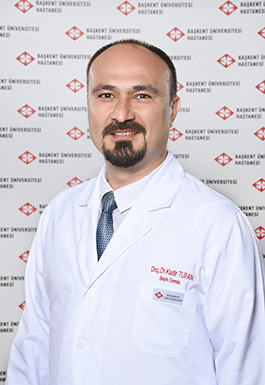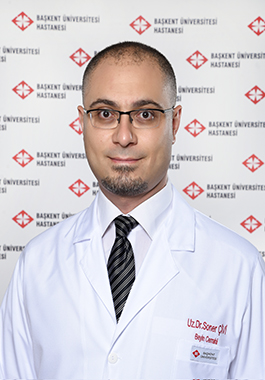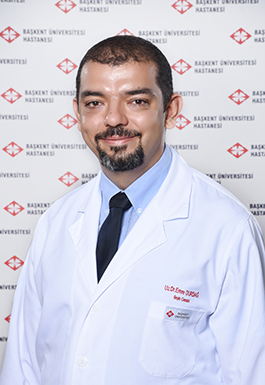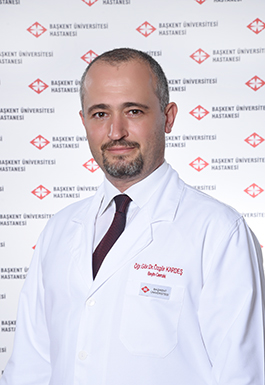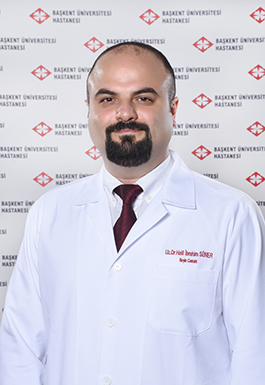Looking at the dictionary meaning, the word "Neurosurgery" is derived from "Neuron" and "Surgery." Although it is thought to be of foreign origin, the word "Surgery" actually has Turkish roots and means "healer of wounds." "Neuron" is of Latin origin and means nerve cell. In this context, it is generally used to describe the nervous system. Neurosurgery, in short, is surgery of the nervous system. It deals with the surgical treatment of:
- Tumors originating from or externally compressing the brain or spinal cord tissue,
- Disorders of the vessels feeding the brain tissue or spinal cord, such as aneurysms (ballooning), arteriovenous malformations, cavernomas, and narrowing of the neck vessels known as carotid stenosis,
- Disorders that develop during the formation of the nervous system, such as meningomyelocele present from birth,
- Hydrocephalus, which roughly refers to an increase in the fluid in the brain spaces,
- All kinds of spinal diseases, including herniated discs,
- Head and spinal cord injuries,
- Blockages of brain vessels,
- Hemorrhages of the brain.
Brain Tumors
General Classification
A significant group of diseases in neurosurgery consists of brain tumors. Generally, brain tumors can be classified as malignant (cancerous) and benign (non-cancerous).
I. Malignant Tumors
A. Glial Tumors: These are the most common brain tumors and constitute the majority of brain cancers. They contain cells with uncontrolled proliferation characteristics. They grow rapidly, extending into surrounding healthy tissue, and rarely can spread to the spinal cord and even other organs of the body. Staging is done in four groups. Stages I and II are called "low-grade," while Stages III (anaplastic astrocytoma) and IV (glioblastoma multiforme) are considered "high-grade." Other tumors in this group include ependymomas, medulloblastomas, and oligodendrogliomas. Survival times are related to pathological staging, radiotherapy, chemotherapy, and age. For low-grade glial tumors, survival time is long. For high-grade gliomas, the average life expectancy is much shorter.
B. Metastatic Brain Tumors: These tumors result from the spread of a tumor from another part of the body to the brain. They most commonly originate from the lungs, breasts, colon, stomach, skin, or prostate. However, sometimes the primary organ cannot be determined. Brain metastases are found in 20-40% of patients diagnosed and hospitalized for treatment in oncology clinics. These cases constitute 10% of all brain tumors. If possible, stereotactic surgery under local anesthesia for biopsy is preferred for accurate diagnosis and facilitates treatment selection.
Treatment options for malignant brain tumors include surgical intervention, biopsy, radiation therapy, medication, and radiosurgery. The response to treatment depends on factors such as the origin of the tumor, the number of organs it has spread to, the number of metastatic lesions, the patient's age, and the presence of other diseases. Therefore, survival times vary.
II. Benign Tumors
These tumors usually develop inside the skull but outside the brain tissue. Meningiomas, pituitary adenomas, craniopharyngiomas, dermoid and epidermoid tumors, hemangioblastomas, colloid cysts, subependymal giant cell astrocytomas, and neurinomas are among the most common lesions in this group. Meningiomas form a significant portion of this group. Unlike benign tumors in other organs, benign brain tumors can sometimes cause life-threatening conditions. Some (e.g., meningiomas) can rarely turn into malignant tumors. They generally do not spread to surrounding brain tissue, so they have a high chance of being completely removed by surgery. However, they can recur, albeit rarely. Even if meningiomas are completely removed, there's a 20% chance of recurrence within 10 years, and there can be complications after surgery, especially in those attached to critical areas.
Symptoms
Patients with brain tumors may present with one or several complaints such as headache, vomiting, nausea, vision impairment, consciousness disturbance, seizures, weakness in the arms and legs, irritability, loss of appetite, hearing reduction, forgetfulness, difficulty in speaking and understanding, inability to write, imbalance, and enlargement of hands and feet. Headache (usually more intense in the mornings) and seizures are the most common symptoms.
Diagnostic Methods
The diagnosis is usually made with a clinical evaluation, Computerized Brain Tomography (CT), or Magnetic Resonance Imaging (MRI). These tests can be repeated with contrast to better define the tumor's boundaries and characteristics. The definitive diagnosis is made after pathological examinations. Other helpful tests include direct skull radiographs, EEG, whole-body bone scintigraphy, and hormone studies.
Treatment Methods
Surgical removal of the tumor is generally considered the first option for almost all brain tumors. In a small percentage, partial removal or radiotherapy and follow-up are recommended due to high complication rates. Especially in high-grade glial tumors, after the diagnosis is confirmed by biopsy, radiosurgery or chemotherapy (drug therapy) may be preferred over tumor removal. For some benign lesions located in the brain stem, surgery may be possible, while radiosurgery (Gamma Knife, Linear Accelerator=LINAC) may be applied in others. In short, the malignancy degree and location of the tumor, the patient's age, general condition, and the presence of additional systemic problems, determine the surgical decision and the limits of tumor removal.
In summary, today, the treatment of brain tumors generally involves surgical, radiotherapy (radiation therapy), radiosurgery, and chemotherapy (drug treatment) methods used separately or in combination, depending on the pathological diagnosis of the tumor.
Post-Surgery Possible Complications
Post-surgery complications are not independent of the type of tumor, its location, the patient's age, and general condition. Some of these complications may include seizures, severe headaches, nausea, vomiting, bleeding, further worsening of the existing neurological condition, disturbances in vision, speech, and perception, hydrocephalus, swelling and redness in the limbs, delayed wound healing, infection, thromboembolism, psychiatric problems, and other potential surgical complications. Most of these complications can be resolved with postoperative medical care, though some (such as worsening of the neurological condition) can be permanent. One or more of these complications can develop in the same patient. However, it's important to remember that the systemic problems created by the presence of a tumor in the brain often pose a life-threatening risk.
Follow-up and Recommendations
If the tumor is benign and completely removed, the patient is generally seen in the first and sixth month, then annually. For malignant tumors, follow-up times should be determined considering the follow-ups of the neurosurgeon, medical oncologist (specialist in cancer drug treatment), radiation oncologist (specialist in cancer radiation treatment), and physical therapy and rehabilitation departments. Writing the necessary tests at discharge facilitates the patient's appointment management. If the patient experiences any problems (such as headache, seizure, consciousness disturbance, weakness in arms or legs, etc.) during follow-up, they should contact the clinic where they were treated, the emergency service, or their treating physician.
Some Definitions
Benign: A tumor without cancerous characteristics, typically slow-growing.
Biopsy: A small piece taken from the tumor tissue to determine the tumor type in pathological examination. If possible, performing it with stereotactic surgery rather than open surgery can lead to fewer complications.
Burr Hole: A hole drilled in the skull. It is done to remove bone, drain blood or abscess, or for biopsy purposes.
Grade: A special designation used in grading tumors and determining some of their characteristics. For example, a “grade” I tumor grows slowly, while a “grade” IV tumor grows rapidly.
Chemotherapy: The use of drugs, given orally or intravenously, for cancer treatment.
Craniotomy: Removing a piece of skull bone and replacing it after surgery.
Malignant: A term for tumors (cancers) with uncontrollably proliferating cells.
Survival: Can be expressed as survival time or lifespan.
Radiotherapy: Treating a tumor with radiation rays or radiation treatment.
Pituitary Adenomas and Hormonal Disorders
There are two main systems that control the body's functions. One is the "nervous system" which originates from the brain and spinal cord and spreads throughout the body. The other is the "hormonal system" or "endocrine system" which circulates in the blood and regulates body functions. These two systems work interconnectedly. Hormones are chemical substances secreted by cell groups or glands in the body. There are two glands in the brain that belong to the endocrine system. The first is the pituitary gland, and the second is the pineal gland. Tumors involving the pineal gland are very rare, while tumors involving the pituitary gland account for 5-10% of all brain tumors.
Pituitary gland tumors adversely affect the body in two ways. The first harmful effect is exerted by compressing the surrounding structures as they grow beyond their normal size. In this scenario, particularly the optic nerve near the gland is affected, leading to decreased vision or vision loss in patients. If the tumor grows further, there can also be a loss of function in the nerves that control eye movements. When the pituitary gland reaches such large sizes, the normal pituitary tissue loses its function, resulting in deficiencies in various hormones secreted by the pituitary. Tumors causing the first effect are referred to as macroadenomas. The tumor's second harmful effect manifests either by excessively enlarging the pituitary gland or by causing over-secretion of certain hormones without significant enlargement. If the pituitary gland has grown to a size not exceeding 1 cm, these tumors are called microadenomas. The pituitary gland consists of two parts: the anterior pituitary and the posterior pituitary. Pituitary gland tumors are primarily tumors of the anterior pituitary.
The hormones secreted from the anterior pituitary and their functions are as follows:
Prolactin hormone, causes milk secretion from the breast.
Growth hormone; controls carbohydrate, fat, and protein metabolism in the body. It especially ensures the balanced growth of the body during puberty.
Adrenocorticotropic hormone; regulates the secretion of cortisol, which is of vital importance, from the adrenal glands.
Thyroid-stimulating hormone; causes the secretion of thyroid hormones from the thyroid gland.
Gonadotropic hormones; control the functions of the reproductive organs.
Within the pituitary gland, the over-secretion of one or two of the above-mentioned hormones by cell groups leads to an increase in the functions of those hormones in the body. In this case, for example, if excess prolactin is secreted, the patient may have milk discharge from the breast even though she is not pregnant. In adults, if excess growth hormone is secreted, the body may grow excessively, causing shoes to become too tight. From the posterior pituitary, the antidiuretic hormone, which regulates urine output from the body, and oxytocin, which causes uterine contractions during childbirth, are secreted. Tumors of the posterior pituitary are almost never seen.
There are three approaches to the treatment of pituitary tumors: medication, surgery, and radiation therapy. Medication can control excessive hormone secretion. However, in most patients, hormone secretion returns to its previous level when medication is discontinued. For example, in a tumor secreting excessive prolactin, if the patient wants to become pregnant, the medication must be discontinued due to its side effects on the unborn baby. The patient may need to take the medication for the rest of her life.
The aims of surgical treatment are as follows: to relieve the pressure of the tumor on surrounding tissues, such as the optic nerves, and to reduce the size of the tumor mass to improve response to medical treatment. Surgery is also required for tumors that do not respond to medication. In cases like a macroadenoma causing sudden vision loss or bleeding into the tumor, surgery should be performed immediately. Surgical treatment is primarily performed in two ways: the transsphenoidal route through the nose and opening the skull bone from above to remove the pituitary tumor.
Radiation therapy is preferred for pituitary tumors that cannot be controlled with medication and surgery or extend to areas that are risky to access surgically.
Today, the transsphenoidal route is preferred for the surgical treatment of pituitary tumors. The rates of complications that patients may encounter due to transsphenoidal surgery are listed below:
Anesthesia complications 2.8%
Carotid artery rupture 1.1%
Brain tissue damage 1.3%
Hematoma in incompletely removed tumor tissue 2.9%
Vision loss 1.8%
Paralysis of eye movements 1.4%
Cerebrospinal fluid leak 3.9%
Meningitis 1.5%
Perforation of the septum inside the nose 6.7%
Nosebleed 3.4%
Sinusitis 8.5%
Anterior pituitary hormone deficiency 19.4%
Diabetes insipidus 17.8%
Death 0.9%
Radiosurgery Technology in Brain Tumor Treatment
Gamma Knife
It is a method that allows the surgical treatment of abnormal tissues developing in the brain without any surgical incision. Gamma Knife uses a technique called stereotactic radiosurgery. It is a treatment system that destroys diseased tissue with gamma rays at coordinates determined for the patient.
The system is based on the principle of transferring a very high energy by converging 201 individually positioned rays from separate sources, each with energy harmless to normal brain tissue, at one point (diseased brain tissue), thereby eliminating this tissue. It offers the possibility of applying high energy in one session, completing the treatment in one session. It is generally preferred in cases where open brain surgery is not possible or carries a high risk.
OUR EXPERIENCED GAMMA KNIFE TEAM HAS SUCCESSFULLY TREATED A TOTAL OF 3793 PATIENTS BETWEEN 2013-2023.
